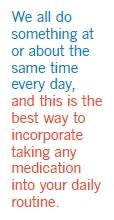
“Hello, this is your pharmacy calling to tell you that your medication is ready for pickup.”
I hear this message at least once a month. When I do, I go pick up my prescriptions from the pharmacy. But some people, for a plethora of reasons, never pick up their meds. So what happens? Many unused, unopened, never picked up medications are destroyed when someone, somewhere could be using them to bring their HIV virus (or viral load) from uncontrolled to undetectable. If you refuse medication at the pharmacy level they can return it to stock, and if it’s never picked up after two weeks it’s also placed back in stock. However, this becomes tricky once the prescriptions are delivered to a person’s home or a health care facility, and these are the medications that are going to waste. And this is a shame, because we tighten our belts and figure out a way to keep programs active; however, we can’t work with gaping, bleeding wounds.
HIV medications have always been expensive and the newer once-a-day formulas that most people begin these days are even more costly. People employed full time should have health insurance through their employers and some can pay their own premiums, but many people have the “non-Cadillac” insurance that charges very high co-pays for HIV medications as well as other expensive ones such as those for hepatitis C and chemotherapy. Many are enrolled in the pharmaceutical manufacturer’s Patient Assistance Program (PAP) and some of them still need to apply for the AIDS Drug Assistance Program (ADAP), which completely covers the cost of their HIV medications, and in some cases co-pays or premiums.
These programs ship medication to either the patient’s house or their health care provider’s office. The problem is that when patients do not pick up their medications they pile up and after a while either become expired or have to be destroyed. Some places link with aidforaids.org, and send the medications so they can be distributed to people who need them desperately in places like Africa.
While this is a wonderful way to not waste medications, it’s too bad the patient the prescription was meant for is not on their HIV regimen. This is where the A-word comes in: adherence. Medications only work when taken properly, and this is adherence in its most basic form.

Can you take a red jelly bean once a day at the same time of the day for a month? I heard about this nifty little experiment years ago when providers asked people who never took medications if they could take a jelly bean candy of the same color at the same time daily for a month and then report their adherence to the provider. Many people found they couldn’t do this, they were too consumed by their everyday life to stop their routine once a day at the same time and do something new and different. We all do something at or about the same time every day, and this is the best way to incorporate taking any medication into your daily routine. This can be a difficult task at first, and as difficult and burdensome as it may be, you may want to try the jelly bean tool—let’s say for two weeks—to see if you can be adherent to your medication, before actually starting the real McCoy.
One of the main reasons many are adherent is because they are taking a once-a-day regimen in one pill, like Stribild or Complera; however, these pills are not one medication but three or four. Stribild is comprised of four separate medications, and Complera is made up of three. Further, these medications come from different classes of HIV drugs and if not taken as directed, daily and around the same time each day, one stands a chance of having their virus mutate, causing one or more of the medications to stop working for them.
There are many people living with HIV and other co-morbidities like diabetes, cancer, or high blood pressure. Most of them are probably used to adhering to a daily routine to stay healthy by taking their medications on time, so they just add another pill to their existing regimen. However, diabetes doesn’t mutate and HIV does. If a diabetic goes off their treatment they can usually restart their same medication.
Not true for HIV medications if you aren’t adherent. When one stops taking the medication correctly, as prescribed (such as every day and with or without food), the HIV might begin to mutate, resistance mutations may develop, and these mutations will show up on a genotype test. Now the patient may need to take three, four, or perhaps five pills a day and believe me, this is much harder than a one-pill-a-day regimen. If possible consider trying the jelly bean trick for a couple of weeks and see how this works out before beginning HIV treatment. Once you know you’re ready to start HIV medications and you can commit to being adherent, go for it.


